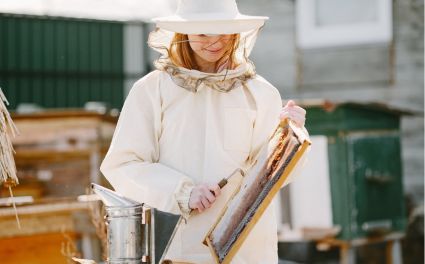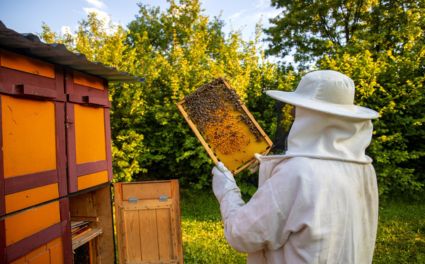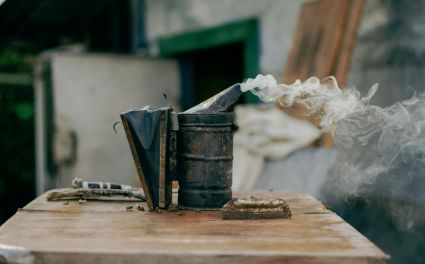The Fascinating Journey from Worker Larva to Hive Royalty
Have you ever pondered the remarkable journey of how a common bee evolves into a queen within a hive? It’s one of nature’s most extraordinary transformations — a story of dedication, cooperation, and perfect balance within a beehive. Inside a honey bee colony, thousands of worker bees labour tirelessly, yet only one reigns supreme — the queen. Her development from a tiny larva to the most vital member of the colony is a process guided by biology, pheromones, and care from the worker bees.
Understanding how a queen bee is created not only unveils the wonders of nature but also deepens our appreciation for the complex world of beekeeping. Whether you’re an enthusiast donning your beekeeping suit or a professional maintaining multiple hives, this journey highlights the intelligence and teamwork that define honey bee colonies.
Egg Laying by the Queen
The queen bee’s life begins much like any other bee — from an egg laid by an existing queen. However, her destiny is shaped by the care and nourishment she receives.
Role of the Queen Bee in Egg-Laying
The queen bee’s primary role is to ensure the survival and continuity of the colony through egg production. A healthy queen can lay up to 1,500 eggs per day during the hive’s active season. Each egg is carefully deposited into a hexagonal wax cell built by worker bees.
Fertilized eggs develop into female bees — either workers or future queens — while unfertilized eggs become male drones. This selective process enables the colony to maintain balance and adapt to environmental conditions.
To protect themselves while inspecting hives during the queen’s egg-laying phase, beekeepers often rely on quality beekeeping jackets and beekeeping gloves, ensuring comfort and safety during hive checks.

The Queen’s Exclusive Diet and Care
The transformation of a larva into a queen begins with her exclusive diet of royal jelly, a highly nutritious secretion produced by worker bees. Unlike ordinary worker larvae, which are fed royal jelly for just a few days, the potential queen receives it throughout her development.
Royal jelly is rich in proteins, vitamins, and fatty acids, which accelerate the larva’s growth and trigger hormonal changes that make her larger, more fertile, and longer-lived than worker bees.
Inside the hive, the queen enjoys special attention. Worker bees groom her, feed her, and protect her from potential threats. This care ensures that she remains healthy and continues her essential role in reproduction.
For beekeepers managing hives, wearing well-ventilated beekeeping veils and beekeeping trousers provides added comfort during these close inspections.
Specialized Cells for Queen Bee Development
When a colony senses the need for a new queen — whether due to the ageing or death of the current one — the worker bees begin an extraordinary process. They build specialized wax structures known as queen cups or queen cells.
What Are Queen Cups?
Queen cups are vertically oriented, peanut-shaped cells that are larger than regular brood cells. They provide enough room for the developing queen larva to grow. Worker bees carefully construct these cells in preparation for emergency situations or when the colony intends to swarm.
These queen cells are usually found on the edges of brood combs, making them easier to access for feeding and maintenance.
The Worker Bees’ Decision to Rear a New Queen
The decision to raise a new queen is not taken lightly. Worker bees detect changes in pheromone levels from the reigning queen. When these signals weaken, they initiate the process by selecting a few young larvae and feeding them royal jelly.
Through this act, worker bees essentially “choose” their next monarch — an incredible example of collective intelligence within the hive.
Larval Development – The Making of a Queen
The selected larva’s journey to becoming a queen is one of rapid growth and transformation. Within just a few days, she grows at an astonishing rate, nourished exclusively on royal jelly.
This diet doesn’t just make her larger; it alters her physiology entirely. She develops fully functional ovaries, a longer abdomen, and pheromones that command respect and unity among worker bees.
Worker bees meticulously maintain the right temperature and humidity in the hive to ensure her successful growth. During this delicate phase, it’s crucial for beekeepers to maintain hive hygiene and stability — something made easier with reliable beekeeping suits that offer both protection and mobility.
The Pupal Stage and Metamorphosis
Once fully fed, the larva spins a thin cocoon inside her queen cell and enters the pupal stage. The cell is then sealed by worker bees with beeswax, creating a protected chamber.
Within this closed cell, the most dramatic transformation unfolds. Over several days, the larva metamorphoses into a fully formed queen bee — complete with wings, reproductive organs, and her signature elongated body.
When the new queen is ready, she chews her way out of the cell, ready to assume leadership. In most cases, if multiple queens emerge at once, only one will survive, as they instinctively compete for dominance.
For beekeepers observing such behaviour, protective gear like beekeeping kids suits and beekeeping ankle protection are invaluable for safety, especially when young learners join in hive inspections or apiary sessions.
Queen Bee Mating – The Flight for the Future
After emerging, the young queen embarks on one of the most important events of her life — her mating flight.
The Mating Flight
On a warm, sunny day, the queen takes to the skies, accompanied by drones from other colonies. She visits several drone congregation areas where male bees gather, waiting for an opportunity to mate.
Multiple Mating for Genetic Strength
During this journey, the queen mates with several drones, collecting and storing sperm in her spermatheca, a specialized organ in her abdomen. This genetic diversity strengthens the entire colony, promoting disease resistance and adaptability.
Once mated, she returns to the hive and begins laying eggs — marking the start of a new generation.
Understanding this life cycle helps beekeepers predict colony behaviour, prevent swarming, and maintain a healthy hive population. To handle hive management with confidence and comfort, many turn to well-designed beekeeping jackets and beekeeping gloves for protection and ease of movement.
The Queen’s Role in Hive Harmony
Once established, the queen bee governs the colony through pheromones — natural chemical signals that influence worker behaviour. Her presence ensures unity, productivity, and order.
If the queen weakens or dies, the colony reacts swiftly by raising a new queen, demonstrating the resilience of honey bees. Every hive’s success depends on this delicate balance, and understanding it helps beekeepers make informed management decisions.
Why This Knowledge Matters for Beekeepers
Recognising how a queen bee is made isn’t just fascinating biology — it’s practical beekeeping knowledge. By identifying queen cells, observing larval stages, and understanding pheromone behaviour, beekeepers can anticipate changes in their colonies.
This understanding becomes even more effective with the right equipment. Protective wear such as beekeeping veils, breathable beekeeping suits, and reinforced beekeeping trousers not only make hive inspections safer but also allow beekeepers to work calmly and confidently.
OZ Armour, known for its high-quality protective gear, has become a trusted name among global beekeepers. Its innovative multi-layer ventilation and durable stitching reflect a deep understanding of what beekeepers need — comfort, mobility, and maximum sting protection.

Conclusion – The Royal Heart of the Hive
The journey of how a bee becomes a queen is nothing short of astonishing. From a simple egg to a revered leader, her transformation depends on the colony’s cooperation, the magic of royal jelly, and the remarkable instincts of worker bees.
For beekeepers, understanding this process offers invaluable insight into maintaining hive balance and productivity. Each phase — from egg to mating flight — reveals how vital harmony and nutrition are within a colony.
As the queen continues her reign, laying thousands of eggs and guiding her subjects, the hive flourishes. Just as bees rely on their queen for stability, beekeepers rely on dependable gear — from beekeeping jackets to beekeeping gloves and beekeeping ankle protection — to nurture thriving colonies safely and efficiently.
For more tips, guides, and insights into apiculture, read more blogs about beekeeping and explore the world of bees through expert insights and protective innovations that support safe, sustainable beekeeping practices.




